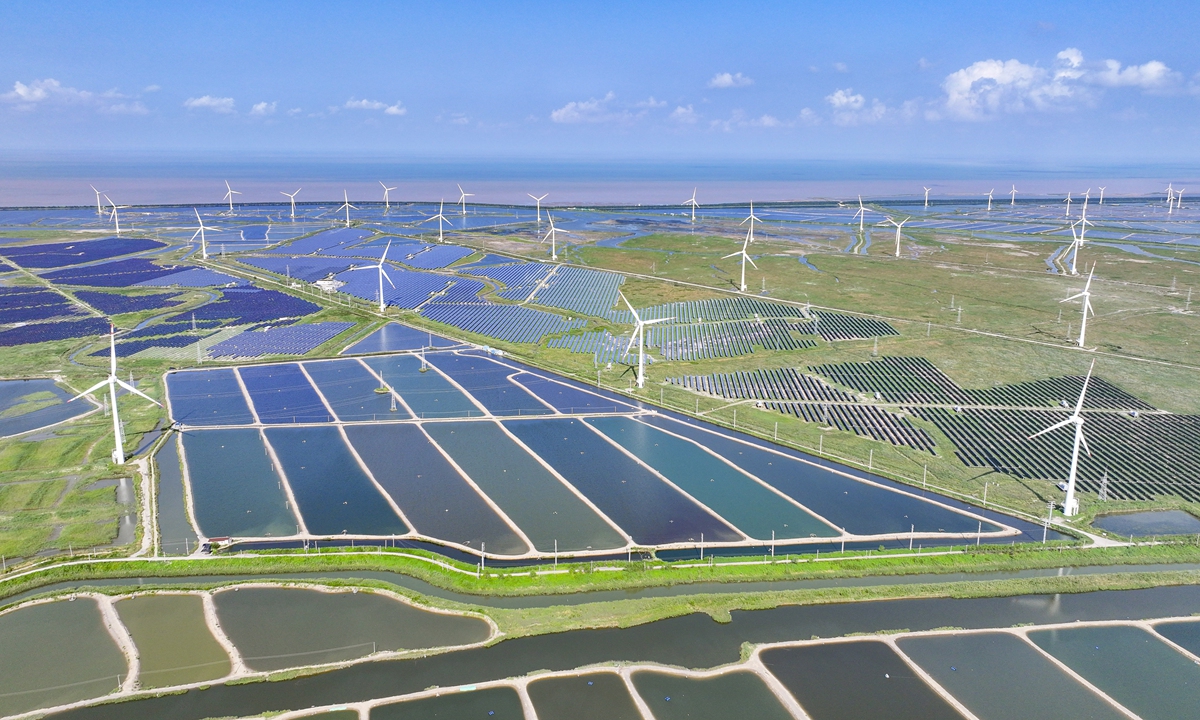
Wind turbines and photovoltaic panels in Yancheng, East China’s Jiangsu Province deliver reliable green energy on August 15, 2024. According to data from the National Energy Administration, as of July, China’s installed renewable energy power generation capacity reached 1.65 billion kilowatts, up 25 percent year-on-year. Photo: VCG
A recent report by the United Nations Environment Programme (UNEP) reveals that global greenhouse gas emission reduction efforts are falling significantly short of targets, which could lead to more dangerous levels of global warming.
The transition to a green economy still faces multiple challenges, including technological, economic, social, policy and international cooperation hurdles.
To avoid the present trajectory of a temperature increase far beyond 2 C over the course of this century, nations must use COP29 in Baku, Azerbaijan, as a launchpad to increase their ambitions and ensure the new Nationally Determined Contributions collectively pledge to almost halve greenhouse gas emissions by 2030, the report released on October 24 said.
"If they do not do so, the Paris Agreement target of 1.5 C will be gone within a few years… The best we could expect to achieve is catastrophic global warming of up to 2.6 C over the course of the century," read the report.
For starters, the analysis of the UNEP's report is backed by scientific validation. With the current progress, the likelihood of worsening climate conditions is substantial, and this has been a significant concern for all of us.
Among the main challenges facing the world, the first one is the inadequate development of new-energy systems. Traditional energy sources, like coal, oil and natural gas, have provided a stable power supply.
However, new-energy systems need to address the challenges posed by potentially unstable sources. This doesn't mean that existing power grids are no longer usable; rather, they require modernization and increased investment to effectively integrate the new-energy sources.
The second challenge is the lack of global cooperation in green transition. This is a significant issue that could contribute to the catastrophic global warming as warned by the UNEP. The urgency to promote green transition has never been greater, necessitating global collaboration.
For example, in the past five years, China's solar power generation has grown by more than 22 percent, while the EU has seen an increase of only more than 11 percent and the US about 13 percent. The EU and the US are slowing down their efforts significantly. However, it's clear that relying solely on China's efforts is not enough. This is a global challenge that demands cooperation among countries to tackle effectively.
Moreover, as the world's largest manufacturer of renewable energy equipment, China continues to supply high-quality new-energy products globally, playing a vital role in stabilizing the supply chain for the clean energy industry.
Yet, the US and certain European countries have used the concept of "overcapacity" as a disguise to undermine China's solar panel and electric vehicle industries.
In reality, China's new-energy industry capacity is an advanced capacity that is urgently needed to promote green development, rather than excess capacity. The Western accusations are categorically groundless and stem purely from geopolitical considerations.
Even in the current urgent situation, it's hard to count on the progress of the green transition in the US and Europe. Rather than fully committing to cooperation, they appear focused on containing China's economic development, hoping to isolate Chinese industries and fill supply chain gaps by supporting countries like India and Mexico.
However, China's advantage in the renewable energy sector comes from its comprehensive industrial chain, which the US and Europe lack, making it difficult for them to compete, let alone surpass China in the short or medium term.
As for China's new-energy industry, it should focus on enhancing its core competitiveness, diversifying its market development globally, and striving for greater influence in climate change discussions, ultimately contributing more to cutting carbon emissions.
The author is director of the China Center for Energy Economics Research at Xiamen University. bizopinion@globaltimes.com.cn



